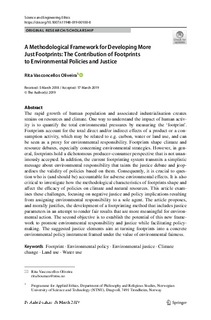| dc.contributor.author | Oliveira, Rita Vasconcellos | |
| dc.date.accessioned | 2019-12-05T08:09:37Z | |
| dc.date.available | 2019-12-05T08:09:37Z | |
| dc.date.created | 2019-03-28T15:58:47Z | |
| dc.date.issued | 2019 | |
| dc.identifier.citation | Science and Engineering Ethics. 2019, 1-25. | nb_NO |
| dc.identifier.issn | 1353-3452 | |
| dc.identifier.uri | http://hdl.handle.net/11250/2631849 | |
| dc.description.abstract | The rapid growth of human population and associated industrialisation creates strains on resources and climate. One way to understand the impact of human activity is to quantify the total environmental pressures by measuring the ‘footprint’. Footprints account for the total direct and/or indirect effects of a product or a consumption activity, which may be related to e.g. carbon, water or land use, and can be seen as a proxy for environmental responsibility. Footprints shape climate and resource debates, especially concerning environmental strategies. However, in general, footprints hold a dichotomous producer–consumer perspective that is not unanimously accepted. In addition, the current footprinting system transmits a simplistic message about environmental responsibility that taints the justice debate and jeopardises the validity of policies based on them. Consequently, it is crucial to question who is (and should be) accountable for adverse environmental effects. It is also critical to investigate how the methodological characteristics of footprints shape and affect the efficacy of policies on climate and natural resources. This article examines these challenges, focusing on negative justice and policy implications resulting from assigning environmental responsibility to a sole agent. The article proposes, and morally justifies, the development of a footprinting method that includes justice parameters in an attempt to render fair results that are more meaningful for environmental action. The second objective is to establish the potential of this new framework to promote environmental responsibility and justice while facilitating policymaking. The suggested justice elements aim at turning footprints into a concrete environmental policy instrument framed under the value of environmental fairness. | nb_NO |
| dc.language.iso | eng | nb_NO |
| dc.publisher | Springer Nature | nb_NO |
| dc.relation.uri | https://link.springer.com/article/10.1007%2Fs11948-019-00100-8 | |
| dc.rights | Navngivelse 4.0 Internasjonal | * |
| dc.rights.uri | http://creativecommons.org/licenses/by/4.0/deed.no | * |
| dc.title | A Methodological Framework for Developing More Just Footprints: The Contribution of Footprints to Environmental Policies and Justice | nb_NO |
| dc.type | Journal article | nb_NO |
| dc.type | Peer reviewed | nb_NO |
| dc.description.version | publishedVersion | nb_NO |
| dc.source.pagenumber | 1-25 | nb_NO |
| dc.source.journal | Science and Engineering Ethics | nb_NO |
| dc.identifier.doi | 10.1007/s11948-019-00100-8 | |
| dc.identifier.cristin | 1688658 | |
| dc.description.localcode | This is an open access article distributed under the terms of the Creative Commons CC BY license, which permits unrestricted use, distribution, and reproduction in any medium, provided the original work is properly cited. You are not required to obtain permission to reuse this article. To request permission for a type of use not listed, please contact Springer Nature. | nb_NO |
| cristin.unitcode | 194,62,70,0 | |
| cristin.unitname | Institutt for filosofi og religionsvitenskap | |
| cristin.ispublished | true | |
| cristin.fulltext | preprint | |
| cristin.qualitycode | 1 | |

